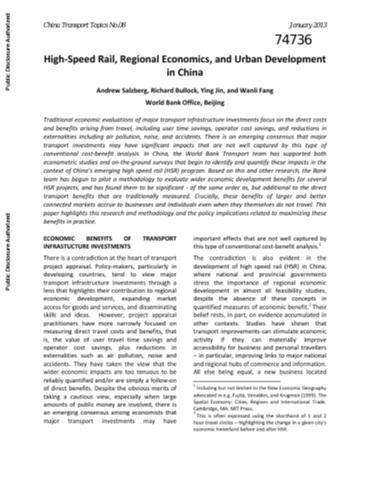The World Bank is a vital source of financial and technical assistance to developing countries around the world. We are not a bank in the ordinary sense but a unique partnership to reduce poverty and support development. The World Bank Group has two ambitious goals: End extreme poverty within a generation and boost shared prosperity.
- To end extreme poverty, the Bank's goal is to decrease the percentage of people living on less than $1.25 a day to no more than 3% by 2030.
- To promote shared prosperity, the goal is to promote income growth of the bottom 40% of the population in each country.
The World Bank Group comprises five institutions managed by their member countries.
The World Bank Group and Land: Working to protect the rights of existing land users and to help secure benefits for smallholder farmers
The World Bank (IBRD and IDA) interacts primarily with governments to increase agricultural productivity, strengthen land tenure policies and improve land governance. More than 90% of the World Bank’s agriculture portfolio focuses on the productivity and access to markets by small holder farmers. Ten percent of our projects focus on the governance of land tenure.
Similarly, investments by the International Finance Corporation (IFC), the World Bank Group’s private sector arm, including those in larger scale enterprises, overwhelmingly support smallholder farmers through improved access to finance, inputs and markets, and as direct suppliers. IFC invests in environmentally and socially sustainable private enterprises in all parts of the value chain (inputs such as irrigation and fertilizers, primary production, processing, transport and storage, traders, and risk management facilities including weather/crop insurance, warehouse financing, etc
For more information, visit the World Bank Group and land and food security (https://www.worldbank.org/en/topic/agriculture/brief/land-and-food-security1
Resources
Displaying 2901 - 2905 of 4907Azerbaijan : Inclusive Growth in a Resource-Rich Economy
Azerbaijan experienced a 'golden
age' in the last decade, during which the average
growth rate reached record high levels and poverty decreased
significantly. On average, the economy grew by 15.3 percent
per year in real terms during this period, mainly driven by
the oil sector (21.5 percent growth per year), but with a
significant contribution from the non-oil sector (11.1
percent per year). As a result, poverty declined
Infrastructure and Employment Creation in the Middle East and North Africa
The state of national labor markets has
always been a concern for governments and development
agencies such as the World Bank. Key labor market
indicators, such as the rate of unemployment, send signals
about the health of an economy and mirror citizens'
attitudes. Being gainfully employed is an important aspect
of an individual's well-being both financially and
socially, as 'initial failures in finding a job can
Planning, Connecting, and Financing Cities--Now : Priorities for City Leaders
This report provides Mayors and other policymakers with a policy framework and diagnostic tools to anticipate and implement strategies that can avoid their cities from locking into irreversible physical and social structures. At the core of the policy framework are the three main dimensions of urban development.
· Planning— where the focus is on making land transactions easier, and making land use regulations more responsive to emerging needs especially to coordinate land use planning with infrastructure, natural resource management, and risks from hazards;
Transforming Cities with Transit : Transit and Land-Use Integration for Sustainable Urban Development
This study explores the complex process
of transit and land-use integration in rapidly growing
cities in developing countries. It first identifies barriers
to and opportunities for effective coordination of transit
infrastructure and urban development. It then recommends a
set of policies and implementation measures for overcoming
these barriers and exploiting these opportunities.
Well-integrated transit and land development create urban
High-Speed Rail, Regional Economics, and Urban Development in China
Traditional economic evaluations of major transport infrastructure investments focus on the direct costs and benefits arising from travel, including user time savings, operator cost savings, and reductions in externalities including air pollution, noise, and accidents. There is an emerging consensus that major transport investments may have significant impacts that are not well captured by this type of conventional cost-benefit analysis.







